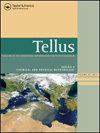北大西洋自由对流层海拔3570 m以上气溶胶光学深度的测量:来自ACE‐2的结果
IF 4.3
4区 地球科学
Q3 METEOROLOGY & ATMOSPHERIC SCIENCES
Tellus Series B-Chemical and Physical Meteorology
Pub Date : 2000-04-01
DOI:10.1034/J.1600-0889.2000.00006.X
引用次数: 25
摘要
作为1997年夏季在加那利群岛和葡萄牙之间的北大西洋地区进行的第二次气溶胶特征实验(ce -2)的一部分,我们在靠近El Teide火山顶部的对流层中部站点(28°16′n, 16°36′W, 3570 m asl)测量了气溶胶光学深度(AOD)。我们的仪器位于太阳光度计网络的最高高度,该网络一直延伸到海平面。清晰的气候条件主导了ACE-2时期,尽管300 hPa的反轨迹表明存在人为污染,但我们的数据中没有发现人为污染的证据。观测到三次不同的尘埃事件。垂直探测和反向轨迹显示来自萨赫勒地区的矿物粉尘是一个来源。在这些事件中,AOD相对于背景条件增加了一个数量级(在λ=500 nm时从0.017增加到0.19)。消光谱依赖趋于中性(埃指数α降至0.13),表明粒径>2 μm的气溶胶粒径分布以粗模为主。在矿物粉尘发作期间的6天内,基于Mie的粒径分布计算得到粒径分布在2 ~ 20 μm之间的单峰分布。在500 nm处,单散射反照率ω0(0.87-0.96)和气溶胶不对称参数g(0.72-0.73)的估计表明,尘埃层在大气顶部造成净冷却强迫。本文章由计算机程序翻译,如有差异,请以英文原文为准。
Measurements of aerosol optical depth above 3570 m asl in the North Atlantic free troposphere: results from ACE‐2
As part of the 2nd Aerosol Characterisation Experiment (ACE-2), conducted during summer 1997 in the North Atlantic region between the Canary Islands and Portugal, we measured aerosol optical depths (AOD) at a mid-tropospheric site, near the top of the volcanic mountain “El Teide”(28°16′N, 16°36′ W, 3570 m asl). Our instrument was located at the highest altitude in a network of sunphotometers that extended down to sea level. Clear conditions dominated the ACE-2 period, and, although suggested by back-trajectories at 300 hPa, no evidence of anthropogenic pollution was found in our data. Three distinct dust episodes were observed. Vertical soundings and back trajectories suggested mineral dust from the Sahel region as a source. During these episodes, AOD increased an order of magnitude with respect to background conditions (from 0.017 up to 0.19 at λ=500 nm). A shift towards neutrality of the extinction spectral dependence (Angstrom exponent α down to 0.13), indicated that the coarse mode (particle diameter >2 μm) dominated the aerosol size distribution. For 6 days during the episodes of mineral dust, a monomodal size distribution between 2 and 20 μm diameter was obtained from Mie based size distribution calculations. Estimates, at 500 nm, of the single scattering albedo ω0(0.87–0.96), and the aerosol asymmetry parameter g(0.72–0.73) suggest that the dust layer causes a net cooling forcing at the top of the atmosphere.
求助全文
通过发布文献求助,成功后即可免费获取论文全文。
去求助
来源期刊
自引率
0.00%
发文量
3
期刊介绍:
Tellus B: Chemical and Physical Meteorology along with its sister journal Tellus A: Dynamic Meteorology and Oceanography, are the international, peer-reviewed journals of the International Meteorological Institute in Stockholm, an independent non-for-profit body integrated into the Department of Meteorology at the Faculty of Sciences of Stockholm University, Sweden. Aiming to promote the exchange of knowledge about meteorology from across a range of scientific sub-disciplines, the two journals serve an international community of researchers, policy makers, managers, media and the general public.

 求助内容:
求助内容: 应助结果提醒方式:
应助结果提醒方式:


